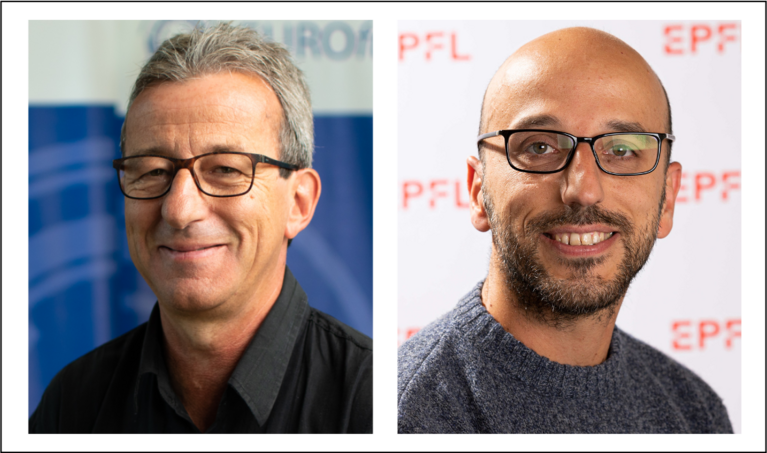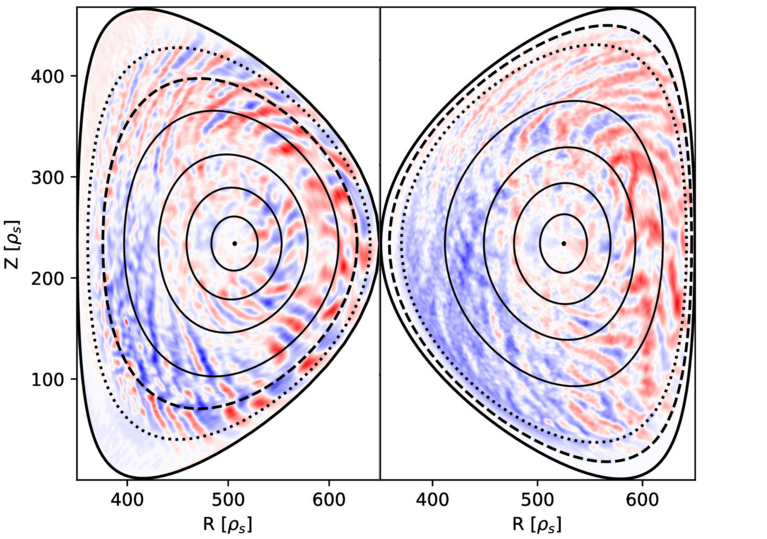March 11, 2022 - by Santina Russo
In February 2022, fusion technology reached a new milestone: Researchers of the joint European undertaking EUROfusion successfully generated 59 megajoules of energy from a 5-second-long plasma pulse using the Joint European Torus (JET) fusion experiment facility located in Oxfordshire in the UK. To better understand the significance of this result along the way towards continuous fusion energy production, we sat down with adjoint professor Laurent Villard and associate professor Paolo Ricci from EPFL. The scientists carry out their research in the framework of EUROfusion and investigate nuclear fusion plasma through simulations using the CSCS supercomputer “Piz Daint”.
Laurent Villard and Paolo Ricci, what exactly makes the recent result achieved with JET “a milestone” in the journey towards nuclear fusion energy?
Laurent Villard: First of all, the experiment in the tokamak-type reactor JET was the first of this magnitude in a long time. Several smaller research reactors do exist worldwide, such as the TCV experiment here at EPFL. But the previous record amount of generated fusion energy from one single experiment dates from 1997 and was also achieved in JET. Since then, JET has been thoroughly reconstructed. In particular, the former reactor walls consisting of carbon were replaced with walls made of a material that is more suitable to harbour the ultra-hot fusion plasma, namely the metal tungsten, which has the highest known melting point — above 3,400 degrees Celsius.
Paolo Ricci: That’s what made it possible to achieve the new record of 59 megajoules. This amount exceeds the previous record by a factor of 2.7. It corresponds to the energy that is generated by burning 1.6 litres of oil.
Not to appear disrespectful, but this doesn’t sound all that impressive.
LV: It is if you consider that the energy was created from a mere 0.1 milligrams of hydrogen and, as a by-product, only released 0.1 milligrams of helium, which is harmless and doesn’t add to climate change at all. In addition, the energy was released from a plasma that was created for only 5 seconds.
PR: This short plasma duration in the experiment is not limited by the fusion reaction, by the way, but by JET’s magnetic coils that create the magnetic field that holds the plasma. They are made of copper and heat up rather quickly, which limits an experiment’s duration. This constraint will be overcome by ITER, however, the larger research fusion reactor that is currently being built in southern France. ITER will have superconducting magnets that won’t heat up, so the machine will be able to handle much longer plasma pulses in the order of magnitude of around 1,000 seconds.
LV: One must keep in mind that ITER will still be a research reactor, meaning that it is not designed to produce electricity to feed into the grid, but perform short fusion experiments that we can learn from. Within 1,000 seconds, it is possible to analyse all processes taking place in a reactor — from the recirculation of the hydrogen isotopes deuterium and tritium that serve as the fuel of the fusion reaction, to the function of the magnetic coils, the interaction of the reactor wall with the plasma, and the turbulence within the plasma that influence its stability – in short, to demonstrate the feasibility of fusion energy. However, for us plasma physicists, relatively short experiments are sufficient since the relevant physics that determine plasma stability are taking place within a time scale below one second.
But is it possible, in principle, to create a continuous plasma to produce energy?
LV: Yes, in principle, it is possible to create a continuous plasma in a tokamak reactor such as JET or ITER by keeping up the current though the machine’s magnetic coils and by additionally heating up the plasma using microwaves. Another possibility is to use another reactor type called stellarator that has a more complex magnetic field, which creates and maintains an intrinsically continuous fusion plasma. In nuclear magnetic confinement fusion research, both reactor types are investigated.
What projects are you currently working on?
LV: Among other things, in my group, we study the type of physics that will now become more interesting thanks to the latest experiment in JET — and with the future experiments in ITER, where the plasma will have a 10-fold larger volume than in JET. In particular, we have used our ORB5 plasma simulation code to study the effect of the high-energy helium that is produced by the fusion reaction in the plasma. The energy of these helium ions is much higher than that of the bulk of the ionised plasma particles. This energy is, in fact, what makes the fusion reaction self-sustaining, but such fast-traveling helium ions can also trigger unwanted instabilities in the plasma. To be able to study the behaviour and the effect of these high-energy particles, we have recently developed a new functionality in the ORB5 code — with the aim to work out how they are driven and how they are damped, and to understand this balance. In addition, we have implemented the modelling of microwave heating in ORB5. Looking ahead to ITER, we need to understand how plasma particles react to such an energy feed and how best to use microwaves to regulate the plasma.
PR: Laurent’s and my research projects are actually complementing each other. While Laurent’s group is specialized in the processes inside the plasma core, my team is focused on the outer rim of the plasma and the interaction between the plasma and the reactor wall. Recently, we performed a large set of simulations on “Piz Daint” to test the effect of factors like input power, size of the device, plasma volume or plasma density on plasma-wall interactions, and plasma turbulence. From the results, we were able to derive the mathematical equation to calculate the maximum achievable plasma density for a certain reactor configuration, meaning the maximum density before plasma turbulence becomes too potent to allow for a confined plasma. Going towards ITER, we have to prepare and learn about such properties and limits. In addition, the community is already focusing on DEMO, the first fusion reactor that is meant to one day bring fusion electricity to the grid.
What are the issues here?
PR: It’s less a question of issues and more one of possibilities. While ITER has long been planned and is being built today, the design work on DEMO has just started. Which also means that we can be more creative. For instance, we can think about different magnet configurations to create different plasma shapes. Thanks to “Piz Daint” we are indeed already simulating plasma shapes of interest for DEMO.
LV: The plasma in a reactor is always donut-shaped, but it can have different forms in the cross section, like circular, elongated, square or D-shaped. We are still working towards understanding the influence of this shape. For one, in a series of simulations, we investigated D-shaped plasma and found that the orientation of this shape — meaning like a D, or like an inverted D — plays a crucial role. Both our simulations and experiments in TCV at EPFL showed that turbulence decreases by a factor of two in a plasma with inverted D-shape. This is a huge improvement.
Why do you need a supercomputer like “Piz Daint” for these simulations?
LV: To understand the processes in the plasma, we perform simulations with 1.6 billion numerical particles, and each of these possesses five degrees of freedom — three spatial ones and two that are related to their velocity. Such a representation results in calculations that are highly demanding in terms of computational resources.
PR: It is clear that without a supercomputer like “Piz Daint”, such simulations could not be done.
Image above: Jet in Oxfordshire, UK, is the largest existing nuclear fusion reactor of the tokamak type. The image shows the interior of the reactor with an illustration of the burning plasma blended in on the right. (Image: Wikimedia commons, EUROfusion)
Further information:
This article may be used on other media and online portals provided the copyright conditions are observed.


